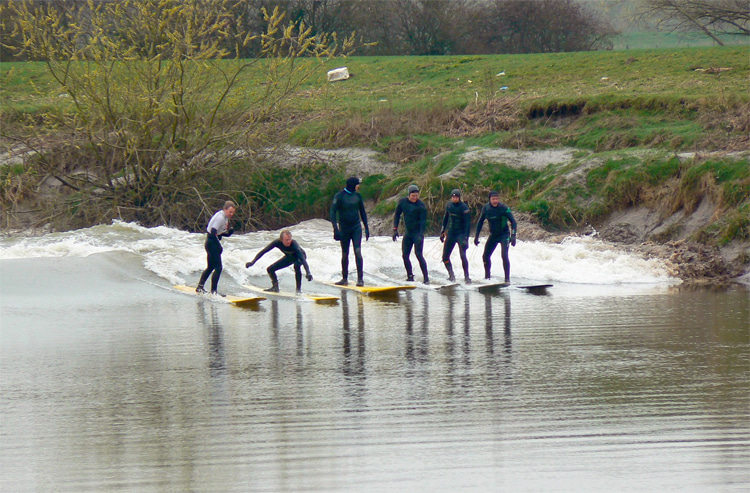It's the United Kingdom's longest wave and runs only a few times per year at maximum quality. Welcome to Gloucestershire's Severn bore.
Tidal bores are a relatively rare phenomenon. There are only around 60 rivers with bores, eight of which are in the UK.
In southwest England, the River Severn is by far the most famous British tidal bore.
It has the world's third-highest tidal range, only behind the Bay of Fundy (North America) and Ungava Bay (Canada).
The English river's height difference between high and low tide could be as much as 49 feet (15 meters).
However, the tidal range combined with Severn's funnel-shaped estuary creates a bigger bore and waves along the way.
The front of the oncoming 12-mile-long (19.3 kilometers) surge of water can be seen at a distance, forming near Fretherne until Maisemore Weir.
In total, the bore can be observed over 21 miles (33.8 kilometers) of river distance, flowing from the entrance of the Bristol Channel (Awre/Fretherne) towards Gloucester (Maisemore).
The Severn estuary gets narrower the further it goes inland.
Near Avonmouth, it is five miles wide (eight kilometers), then at Lydney, it is only one mile wide (1.6 kilometers), and by the time the water gets to Minsterworth, it is less than 100 yards across.
You'll notice an increase in wave height, with the wave dissipating and reforming here and there.
River Severn observes around 260 bores per year, i.e., two per day on approximately 130 days.
However, large bores occur only about 25 days per year, in the morning (9-11 am) and evening (9-11 pm), one to three days after new and full moons.
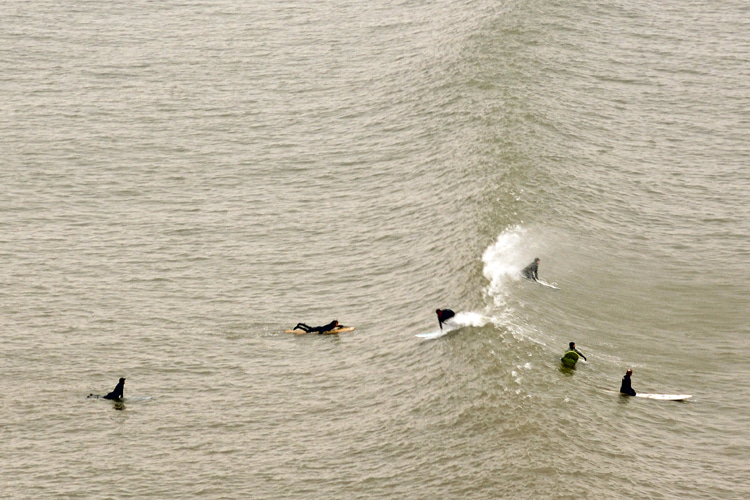
The British River Surfing Pioneers
Lieutenant Colonel Jack Churchill was the first person to surf this tidal wave (1906-1996).
On July 21, 1955, "Mad Jack" rode his custom-made 16-foot surfboard on a five-foot Severn bore wave for over a mile.
"Churchill was a World War II veteran renowned for carrying a Scottish broadsword into battle. He learned to surf after the war," notes Matt Warshaw, author of "The Encyclopedia of Surfing."
Not only was he the first tidal bore surfer, but he also became the first surfer to ride waves in fresh water.
Thirteen years later, in 1968, British surfing champion Rod Sumpter gave it a go, too.
"Then I heard the bore coming: It was a mile away, breaking and smashing against the banks," Sumpter wrote at the time.
"As it rounded a bend three-quarter miles away, I jumped off the bank and paddled into the river where the current swept me downstream at five miles an hour, over sandbars and past spring-green fields."
"Occasionally, a rat or a dead sheep floated by."
"My first problem was to decide where the bore would break and upon which side. The river here was a quarter-mile wide."
"I glanced over my shoulder and saw it rumbling towards me a hundred yards away - peeling off and shaped perfectly."
"I paddled a few more yards from the bank, looked around, and began to stroke as the bore caught up with me."
"I felt the wave pick me up, and then I was standing. I trimmed, cranked a few small turns, and relaxed as I would on any small ocean wave."
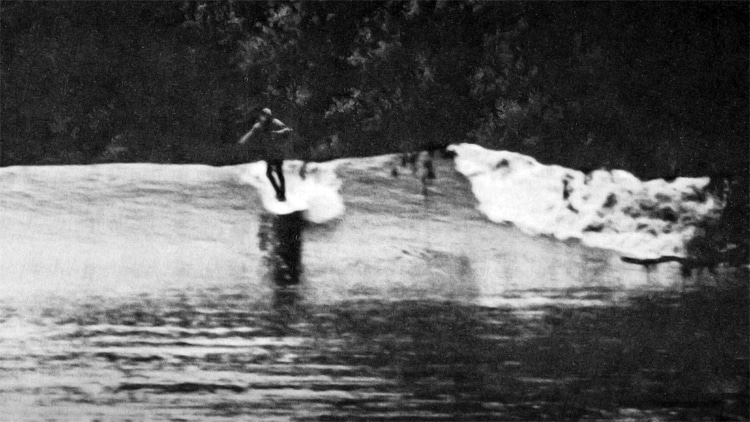
Severn Bore's Star Rating System
Since then, people from all over the world have traveled to Gloucestershire to experience this unique wave.
But when is the best time to surf the English tidal wave at premium quality?
Severn bore locals developed a star system that rates the tidal phenomenon from one (small/poor) to five (large/excellent), according to the riding conditions.
A west-southwest wind will provide extra power behind the bore, resulting in fast, energy-fueled waves that move at a speed of about 8-12 miles per hour (12-19 kilometers per hour).
Also, whenever less freshwater flows in the river, the bore will travel further inland with more power.
Last but not least, low-pressure systems allow water to move around more freely, meaning that the bore will move better upstream.
A nine-meter high tide at Sharpness Docks will typically produce a visible bore somewhere along its course, but the 10-meter plus tide will generate larger surf and attract more spectators.
Although the biggest Severn tidal bores appear during Autumn and Spring tides, nearly any month's high tides will generate a sizeable bore.
You're witnessing a large bore whenever a tide is over 9.5 meters at Sharpness Docks pumping up the river.
The largest bore recorded on the Severn River occurred on October 15, 1966, and measured 9.2 feet (2.8 meters) in height.
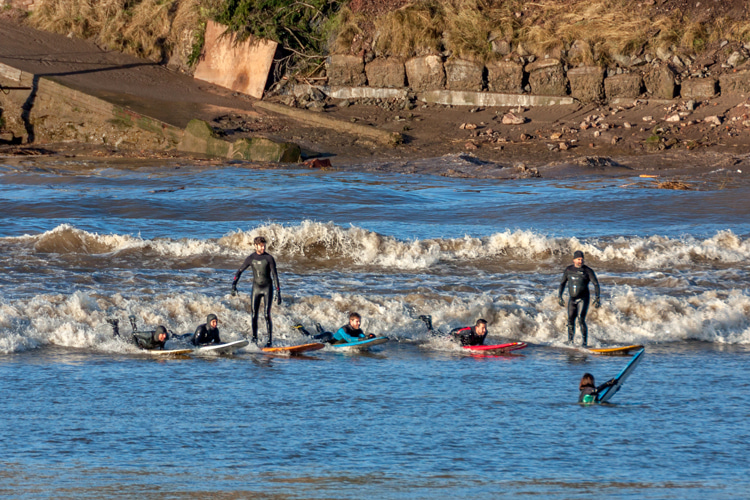
Planning and Riding Strategy
Severn bore's unique experience comes with special requirements, as you're not exactly surfing ocean waves.
Everything is different and peculiar, and first-timers are invited to learn before getting into the fast-flowing, chocolate-brown river waters.
The wave gets you surfing through the English countryside, and you will see cows in the fields, farmers and their tractors, different trees, and the landscape changing as you go along.
Steve King is one of the local legends. He's been riding the famous English bore since 1981.
In 2005, he rode the Severn bore for 9.25 miles (14.88 kilometers), roughly one hour and 15 minutes, setting a new Guinness World Record.
At Severn bore, you can hear the tide coming.
"When you're on a bend, and you're waiting for the tide, once you see all the birds coming round, you know the tide's coming even if you can't see it," explained King.
To ride the tidal bore, you need a wide board with a lot of volume and hardly any rocker.
The wave comes in multiple sections, and you should start paddling early. In some parts of the river and on special days, you'll get bigger and more powerful waves.
There are several take-off zones, but in most of them, you're required to go down and through the muddy side of the banks.
You need to plan your riding strategy - the times, the transportation, the access points, and the plan B or C - for when you fall prematurely.
There is only one wave or tide per day, so it's all about maximizing riding time.
The ten-mile (16-kilometer) rideable Severn bore only features a handful of comfortable access points, so if you fall or miss the wave, you'll have to decide whether to try and rejoin the ride in section B or skip it and go to C.
If you have planned things right, you can get out of the water, back into the car, and then jump back in the water further upstream.
Otherwise, you'll need to wait until the next day to try again.
In most parts of the surfing journey, you'll share the wave with five, ten, or even 20 fellow surfers up the river for a long distance.
And remember that local surfers evaluate an excellent wave in miles.
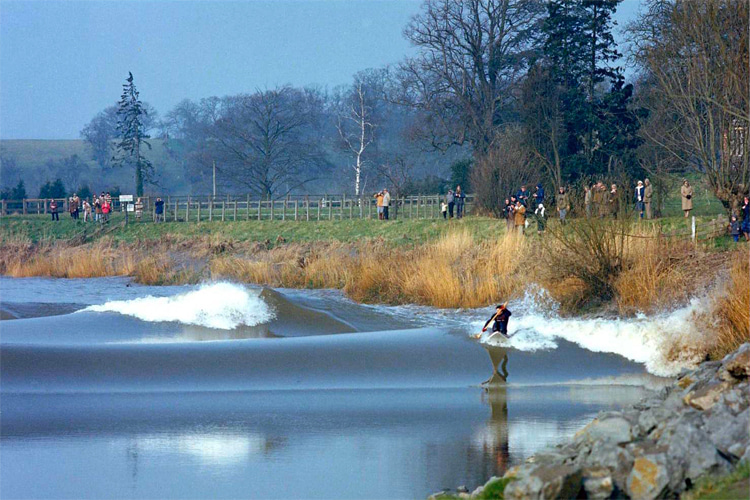
River Surfing Etiquette and Risks
The Severn bore has its dangers - rocks, debris, car tires, livestock, and logs can get in the way, especially closer to the river banks.
It can also get so crowded with surfers and kayakers that it's easy to lose control and hit other water sports enthusiasts.
Keeping a line sometimes means dodging trees and maintaining balance near less experienced riders.
Often, there is little space to maneuver in this river party wave that can be ridden for over an hour.
Like in any river surfing scenario, strong currents, secondary waves, and backwash waves could put your life at risk.
In certain areas, the river hides all sorts of objects under the surface of the water, which can also be extremely dangerous.
Entry and exit to the river have to be carefully thought out. There are a few places that are easily accessible and that are not on private land.
If you fall or wipe out, avoid remaining in the middle of the river channel - boat pilots might not see you following the waves behind the bore.
Motor-powered craft is asked to stay well behind the bore waves and respect the 12-knot speed limit.
Finally, remember that the Severn River is not patrolled by lifeguards.
So, examining the river and talking to locals before entering the water is always a good idea.
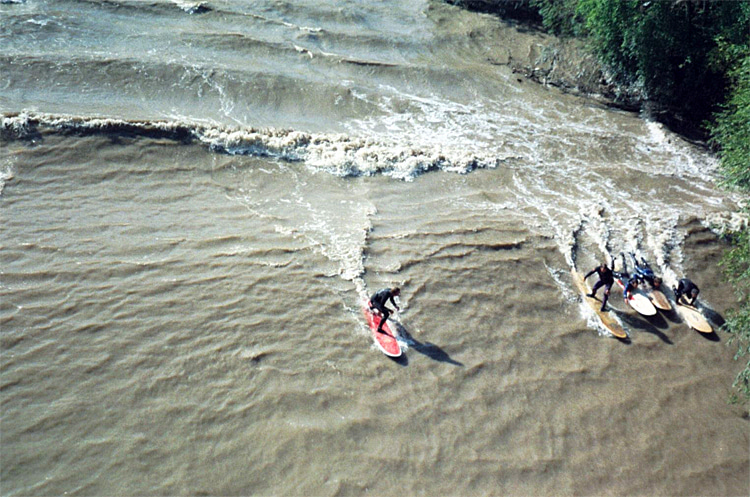
Where to Watch and Surf the Severn Bore
The Severn bore flows for 21 miles (33.8 kilometers).
Depending on the conditions, the total running time varies between two hours and ten minutes and two hours and 35 minutes.
However, due to private land, limited access, no parking areas, and narrow sections and dangerous banks that are suitable for spectators and large crowds, there are only a handful of good viewing spots.
From the south (Newnham) to the north (Maisemore), here are the best Serven bore places to watch surfers and the tidal phenomenon:
- The Old Passage Inn;
- The White Hart Inn;
- The Anchor Inn;
- The Severn Bore Inn;
- The St. Peter's Church;
- The Over Bright;
- The Maisemore Bridge;
The incoming tide and bore wave can be witnessed in all their glory around Epney, Newnham, and Fretherne, where times are 20, 60, and 85 minutes before Minsterworth, respectively.
If you're a surfer, know there are also not many points for easy access and exit to the river.
There are no public slipways, so ask landowners permission to slide into the muddy banks via their properties.
Avoid accessing the river at Hock Cliff (dangerous rocks), Arlingham (deep mud), The Strand/Westbury (hazardous rocks), and Minsterworth Church (shallow and rocky floor).
The bore generally reaches its climax and best rideable conditions between Minsterworth and Lower Parting, Gloucester.
Today, you can predict the best days to surf the Severn bore with high accuracy.
There are yearly timetables published online with the precise times the tidal bore will pass by Newnham, Severn Bore Inn, Minsterworth Church, Stonebench, and Over Bridge.
The British river wave has been featured in surf movies and videos, including "Come Surf With Me" (1968), "Playgrounds in Paradise" (1976), and "Longwave" (2005).
